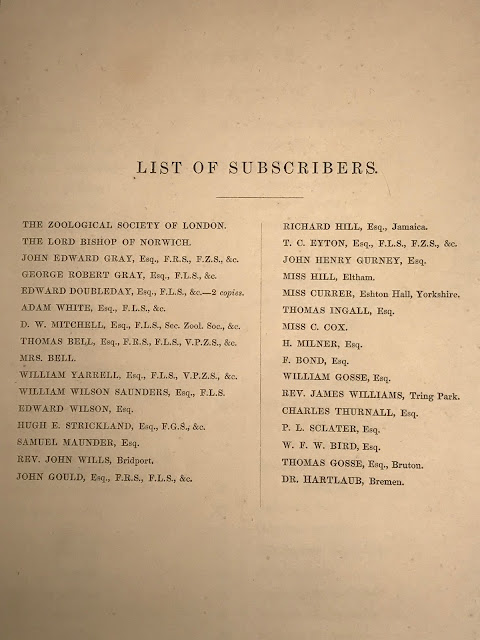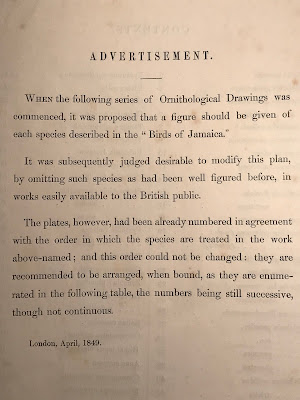Of the works in my collection of P. H. Gosse, this is the most ambitious and largest in scale.
It relates to an earlier book by Gosse, described already in the cataloguing of my Gosse library. This work is, of course, The Birds of Jamaica of 1847.
Gosse undertook to publish a series of lithographic drawings of the birds of Jamaica.
The prospectus printed by Van Voorst and dated 1848 explained that:
The
figures will be drawn on the stone by the author himself, partly from
original drawings, and partly from preserved specimens, with the
advantage of his own notes and personal knowledge of attitudes,
&c.;and they will be very carefully coloured.
Publication
was to proceed as soon as a sufficient number of subscribers would
commit to purchase the work and cover the expenses of outlay.
The
photograph below shows a list of the subscribers which was circulated
with part 12 of the monthly circulation of completed drawings.
This work had a
complex publishing history, but produced some of the most astonishing
works of detailed illustration and colour by Gosse. It will take me
sometime to pull together the cataloguing details for my library, but
the effort will be worth it.
The plan originally was to publish one hundred and twenty plates.
However,as
my example shows (see illustration below), the advertisement in the
printed wrappers, that accompanied Part 12 of the monthly circulation of
completed drawings, read as follows:
It
was subsequently judged desirable to modify this plan, by omitting such
species as had been well figured before, in works easily available to
the British public.
The work ended up
appearing in thirteen monthly parts from April 1848 to April 1849, each
with four loose plates with guard leaves in printed wrappers.
All the wrappers were dated 1848.
The
wrapper in my collection is numbered by hand in ink as Part 12,
although Freeman and Wertheimer note that Part 12 was issued in March
1849.
The list of subscribers is printed on the verso of the back
wrapper, giving the same names that were eventually included in the
finally bound book.A rare plate
The lithographic plates, drawn on the stone and coloured by Gosse himself, were printed by Reeve, Benham and Reeve.
Amongst
the idiosyncrasies within the work, as described by Freeman and
Wertheimer, one particular plate in my possession has a special place.
This is Plate XXXVI, Sylvicola Canadensis.
 |
The rare Plate XXXVI, Sylvicola Canadensis |
It was prepared for
the work, but not used. Freeman and Wertheimer state that four examples
are known. One in a plain uncoloured state at Cambridge University, and
three in Gosse descendants’ hands, one plain, one with the bird coloured
but the background plain, one fully coloured. The plate in my
possession is fully coloured (see illustrated). I do not know whether or
not my plate is the one that was in family possession at the time
Freeman and Wertheimer’s bibliography was being prepared. Either way, it
is a rare plate that was never used in a work that is itself rare.
Curious history
The
plates were finally collected into book form and published as such in
1849. There are no figures for the number of copies produced; it was
certainly small, and the book is scarce today even in libraries. I have
never seen the book.
The plates in my possession have undergone a
curious history. One presumes that they were issued to one of the
thirty-two subscribers, but possibly more.
Some of the plates
bear the holes of a two-ring binder (see below). Such binders were invented in
1896, so it is safe to assume that the holed plates were stored in a ring
binder no earlier than forty-eight years after publication.

The
plates and wrapper from Part 12 of the monthly distribution of plates
to subscribers are stored in a beautifully prepared book-box of leather
and marbled paper, commisioned by book dealer Wheldon and Wesley. The gilt tooling on the spine of the book-box has
floral decorative features and reads: ILLUSTRATIONS OF THE BIRDS OF
JAMAICA - GOSSE
Plates in my collection
The plates with the ring binder holes have been cropped, possibly to fit the binder in which they were held.
Perversely, given their ring bound life, these same holed plates are also darkened, possibly by open display to sunlight
On
the reverse of the plates with the ring binder holes, someone has taken
the time to write in pencil a later and/or corrected scientific name
for each bird illustrated. In each case a volume number and a page
reference is given. I have not been able to identify the reference
source. For example, Gosse describes the bird in Plate XVII as
Certhiola maritima. The note on the reverse describes it as Dendroica
tigrina.
It looks as though these plates are from a file held in
a museum or other institution, where the curator considered them as
reference documents with little intrinsic value.
The plates without ring binder holes remain uncropped.
Two plates are hand-drawn and hand-coloured copies.
In
total 52 plates were distributed to subscribers in 13 parts. This is
much less than the 120 originally projected at the outset of the
subscription offer, which was to have been in an estimated 30 parts or
near. As a consequence of the shortfall, the plate numbering sequence
has significant gaps, as the plates were not issued in numerical order.
There are 52 plates in my collection.
However, this includes the rare XXXVI which was never issued to subscribers.Plate XXIII is missing.
Two
plates in my collection are hand-drawn and hand-coloured artist’s
copies of the originals. One of the artists is Lucinda Kingsley Kefford
(1867-1950). The other is unknown.
The list of plates in my collection
* denotes the presence of ring binder holes and page cropping.
II. Cropped to ring binder size, but not holed.
IV. Cropped to ring binder size, but not holed. Hand-drawn and hand-coloured copy. Artist unknown.
VI.*
VII.*
VIII.*
IX.*
X.*
XII.*
XIV.*
XVI.*
XVII.*
XVIII.
XIV. Original paper glued down on to some sort of backing paper.
XX.*
XXI.*
XXII.*
XXIII Missing
XXIV.*
XXVIII.*
XXXII.*
XXXIV.*
XXXVI.* Rare plate. Bird coloured, background coloured. Not issued to subscribers.
XXXVII.*
XXXVIII.*
XL.*
XLI.*
XLII.*
XLIV.*
XLV.*
LII.*
LIII.*
LVI.*
LVIII.
LIX.*
LX.*
LXI.
LXII.*
LXIV.*
LXV.*
LXVI.*
LXVII.*
LXXIV.*
LXXXIV. Cropped to ring binder size, but not holed. COPY hand-drawn and hand-coloured by Lucinda Kingsley Kefford (1867-1950).LXXXV. Cropped and stuck down on paper in turn cropped down to ring binder size, but not holed.
XC.*
XCIII.*
CII.*
CIV.*
CVIII.*
CX.*
CXI.*
CXIII.*
CXX.*
A selection of the plates













































.jpg)





.jpg)

.jpg)
.jpg)








